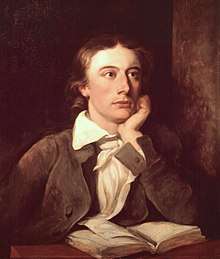The Eve of St. Agnes
The Eve of St. Agnes is a Romantic narrative poem of 42 Spenserian stanzas set in the Middle Ages. It was written by John Keats in 1819 and published in 1820. The poem was considered by many of Keats' contemporaries and the succeeding Victorians to be one of his finest and was influential in 19th-century literature.[1]

The title comes from the day (or evening) before the feast of Saint Agnes (or St. Agnes' Eve). St. Agnes, the patron saint of virgins, died a martyr in 4th century Rome. The eve falls on 20 January; the feast day on the 21st. The divinations referred to by Keats in this poem are referred to by John Aubrey in his Miscellanies (1696) as being associated with St. Agnes' night.
Background
Keats based his poem on the folk belief that a girl could see her future husband in a dream if she performed certain rites on the eve of St. Agnes; that is she would go to bed without any supper, undress herself so that she was completely naked and lie on her bed with her hands under the pillow and looking up to the heavens and not to look behind. Then the proposed husband would appear in her dream, kiss her, and feast with her.
A Scottish version of the ritual would involve young women meeting together on St. Agnes's Eve at midnight, they would go one by one, into a remote field and throw in some grain, after which they repeated the following rhyme in a prayer to St. Agnes:
“Agnes sweet, and Agnes fair, Hither, hither, now repair; Bonny Agnes, let me see The lad who is to marry me.”
In the original version of his poem, Keats emphasized the young lovers' sexuality, but his publishers, who feared public reaction, forced him to tone down the eroticism.
Keats started writing this seminal work while staying in Chichester. He travelled to Chichester, probably arriving on St Agnes’ Day, 20th January 1819. It is said that the medieval architecture of Chichester inspired the great hall and house where Madeline lived. [2]
A statue of Keats resides in Eastgate Square in Chichester to commemorate the fact he started this poem there. The statue was unveiled by Chichester-based actress Dame Patricia Routledge. [3]
Plot

On a bitterly chill night, an ancient beadsman performs his penances in the chapel next to the castle of Madeline's warlike family.
Meanwhile, in the castle, an alcohol-fueled revelry has begun among the family. Madeline pines for the love of Porphyro, sworn enemy to her kin. She has heard 'old dames full many times declare' that she may receive sweet dreams of love from her lover Porphyro if, on this night, St. Agnes' Eve, she retires to bed under the proper ritual of silence and supine receptiveness.
Later that night, Porphyro makes his way to the castle and braves entry, seeking out Angela, an elderly woman friendly to his family, and importuning her to lead him to Madeline's room at night, where he may but gaze upon her sleeping form. Angela is persuaded only with difficulty, saying she fears damnation if Porphyro does not afterward marry the girl.
Concealed in an ornate, carven closet in Madeline's room, Porphyro watches as Madeline makes ready for bed. Beholding her full beauty in the moonlight, he creeps forth as she sleeps, to prepare a feast of rare delicacies. Madeline wakes and sees before her the same image she has seen in her dream and, thinking Porphyro part of it, receives him into her bed. Waking in full and realizing her mistake, she tells Porphyro she cannot hate him for his deception since her heart is so much in his, but that if he goes now he leaves behind "A dove forlorn and lost / With sick unpruned wing".
Porphyro declares his love for Madeline and promises her a home with him over the southern moors. They flee from the castle, passing insensate, drunken revellers and rush into the night. Angela's death is revealed in the poem's final stanza and the beadsman, "after thousand aves told, / For aye unsought for slept among his ashes cold".
Alluded to by others
- Rudyard Kipling's short story "Wireless" (1902) has the narrator witnessing a recreation of the poem by a man in a trance who, by virtue of the similarities of his situation to that of Keats (he is a consumptive apothecary's assistant), becomes "tuned" to the poet.[4]
- Four lines from the final stanza of Keats' poem form the motto of H. P. Lovecraft's 1926 story "The Outsider".
- Six lines are quoted in David Duncan's novel Magic Casement (1990), describing "A casement...diamonded with panes of quaint device....", alluding to the casement window of the title.
References
- Sperry, Stuart M. (1993). "Romance as Wish Fulfillment: The Eve of St. Agnes", in Romantic Poetry: Recent Revisionary Criticism edited by Karl Kroeber and Gene W. Ruoff. New Brunswick NJ: Rutgers University Press. pp. 373–85. ISBN 978-0813520100. Retrieved 24 May 2017.
- ""John Keates in Chicester"". The History Guide.
- ""Take a seat next to Keats"". Chichester Observer.
- ""'Wireless'"". The Kipling Society.
External links
| Wikisource has original text related to this article: |
- 'St. Agnes Eve', Text of 'St. Agnes' Eve' by Keats from Bartleby.
- The Eve of St. Agnes at Internet Archive (scanned books color illustrated). Notable editions:
- The Eve of St. Agnes (1900) calligraphy by Ralph Fletcher Seymour, "Introduction" by Edmund Gosse
- The Eve of St. Agnes (1885) illus. by Edmund H. Garrett
- The Theme of The Eve of St. Agnes in the Pre-Raphaelite Movement, An analysis of the poem at Victorianweb
- CUNY Brooklyn page on the Eve of St Agnes

